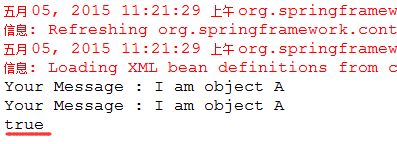在spring中使用<bean/>标签定义bean的时候,可以使用scope属性来定义bean的作用域.如果想要每次
从spring容器得到一个新创建的bean实例,可以指定scope="prototype";如果想要每次从spring容器得
到同一个bean实例,可以指定scope="singleton"
spring中bean的作用域有如下5种类,其中有3中适用于web应用程序.5中作用域的介绍如下:
| 作用域 | 说明 |
| singleton | 单例bean.整个IOC容器中只有该bean的一个实例 |
| prototype | 原型.每次从spring IOC容器中得到的都是新创建的bean |
| request | 每次http请求都会创建一个bean.只适用于web应用 |
| session | 每个session共用一个bean.只适用于web应用 |
| global-session | 整个web应用中只会实例化一次该bean |
本文我们只介绍singleton和prototype作用域.
singleton作用域
在spring IOC容器中的bean如果scope指定为singleton,那么该bean在此IOC容器中只会存在一个实例.
首次从spring IOC容器中获得该bean的时候,spring IOC容器会实例化并装配该bean,随后把该bean
缓存起来,以后在从spring IOC容器取得该bean的时候,IOC容器会把缓存的bean实例返回.
下面看一个singleton作用域的例子程序.
1.创建com.tutorialspoint.scope.singleton包,并在包中创建HelloWorld.java类,内容如下:
package com.tutorialspoint.scope.singleton; public class HelloWorld { private String message; public void setMessage(String message) { this.message = message; } public void getMessage() { System.out.println("Your Message : " + message); } }
2.在src目录下,创建scope_singleton.xml配置文件,内容如下:
在配置文件中,指定bean的作用域为singleton.
<?xml version="1.0" encoding="UTF-8"?> <beans xmlns="http://www.springframework.org/schema/beans" xmlns:xsi="http://www.w3.org/2001/XMLSchema-instance" xsi:schemaLocation="http://www.springframework.org/schema/beans http://www.springframework.org/schema/beans/spring-beans-3.0.xsd"> <bean id="helloWorld" class="com.tutorialspoint.scope.singleton.HelloWorld" scope="singleton"/> </beans>
3.在包com.tutorialspoint.scope.singleton中创建MainApp.java,内容如下:
package com.tutorialspoint.scope.singleton; import org.springframework.context.ApplicationContext; import org.springframework.context.support.ClassPathXmlApplicationContext; public class MainApp { public static void main(String[] args) { //实例化spring IOC容器 ApplicationContext context = new ClassPathXmlApplicationContext("scope_singleton.xml"); //从容器中得到作用域为singleton的helloWorld bean.并强制转换为HelloWorld HelloWorld objA = (HelloWorld)context.getBean("helloWorld"); //调用objA的setMessage方法,给成员变量message赋值 objA.setMessage("I am object A"); //打印objA的成员变量message objA.getMessage(); //再次从spring IOC容器中得到作用域为single的的helloWorld bean HelloWorld objB = (HelloWorld)context.getBean("helloWorld"); //直接得到objB的成员变量message,可以发现objB的message也被赋值了,说明从IOC容器中得到的是同一个bean实例 objB.getMessage(); //再次确认,看看objA和objB所引用的对象是否是同一个对象,从打印信息中可以验证objA和objB确实是同一个对象 System.out.println(objA==objB); } }
4.运行程序验证结果,如下:

最后我们修改scope_singleton.xml配置文件,把scope="singleton"去掉,再次运行程序.发现两次运行
结果完全一致.这就证明了:spring IOC容器所管理的bean的作用域默认情况下是singleton
prototype作用域
spring IOC容器所管理的scope为prototype的bean,在每次用户请求从IOC容器中得到该bean的时候,都
会新创建该bean的一个实例,并返回给用户.一般情况有状态的bean的scope会被设置为prototype;无状态
bean的scope设置为singleton.(可以简单的认为有成员变量,并且会对该变量进行修改的类都是有状态的).
下面做实验,实验代码跟singleton例子中的代码完全一致,只是配置元数据不同.还是在敲一遍吧
1.新建包com.tutorialspoint.scope.prototype,并在包中新建HelloWorld.java,内容如下:
package com.tutorialspoint.scope.prototype; public class HelloWorld { private String message; public void setMessage(String message) { this.message = message; } public void getMessage() { System.out.println("Your Message : " + message); } }
2.在src目录下新建scope_prototype.xml文件,内容如下:
<?xml version="1.0" encoding="UTF-8"?> <beans xmlns="http://www.springframework.org/schema/beans" xmlns:xsi="http://www.w3.org/2001/XMLSchema-instance" xsi:schemaLocation="http://www.springframework.org/schema/beans http://www.springframework.org/schema/beans/spring-beans-3.0.xsd"> <!-- 指定helloWorld bean的scope作用域为prototype --> <bean id="helloWorld" class="com.tutorialspoint.scope.prototype.HelloWorld" scope="prototype"/> </beans>
3.在包com.tutorialspoint.scope.prototype中新建类MainApp.java,内容如下:
package com.tutorialspoint.scope.prototype; import org.springframework.context.ApplicationContext; import org.springframework.context.support.ClassPathXmlApplicationContext; public class MainApp { public static void main(String[] args) { //实例化spring IOC容器 ApplicationContext context = new ClassPathXmlApplicationContext("scope_prototype.xml"); //从容器中得到作用域为prototype的helloWorld bean.并强制转换为HelloWorld HelloWorld objA = (HelloWorld) context.getBean("helloWorld"); //设置objA的message成员变量 objA.setMessage("I'm object A"); //得到objA的message成员变量 objA.getMessage(); //再次从spring IOC容器中得到作用域为prototype的helloWorld bean HelloWorld objB = (HelloWorld) context.getBean("helloWorld"); //获取objB的message的成员变量.发现message为null,证明objA和objB不是同一个实例 objB.getMessage(); //进一步验证objA和objB所引用的对象是否是同一个 System.out.println(objA==objB); } }
4.运行程序,验证结果,发现IOC容器中scope为prototype的bean会为每个请求重新创建实例.
